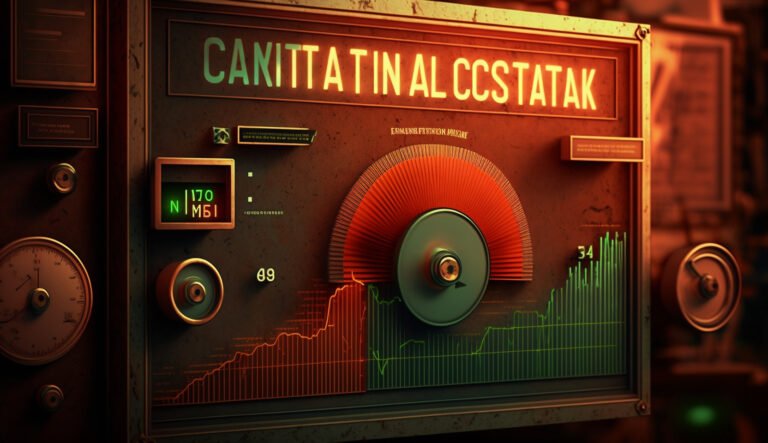
When it comes to understanding economics, there’s one thing that really matters. And that’s economic indicators. These are like the backbone of everything we know about the economy. They help us understand the health of our economy. They also show us the direction it’s heading in and what we can expect in the future. At their most basic level, what’s an economic indicator? Well, it’s a piece of economic data. But this isn’t just any data. It’s usually big-picture data, what we call macroeconomic. We use these indicators to understand what’s happening right now. But we can also use them to predict what might happen in the future. This helps us make decisions about where to invest our money. It also helps us understand the health of the economy.
Why Are Indicators So Important?
Well, economic indicators give us a quick look at how our economy is doing at any given moment. By looking at data over time, we can spot trends and patterns. These help us predict what might happen in the future. For example, if our GDP is growing, that could mean our economy is doing well. But if unemployment is high, that might mean we’re heading for a downturn.
For businesses, understanding these indicators is really important. They use them to plan their strategies. Let’s say the indicators suggest a recession might be coming. A business might decide to produce less or delay plans to expand. But if the indicators suggest our economy is growing strong, a business might decide to do more to make the most of it.
For investors, these indicators can be a signal. They can signal where to invest their money. Positive changes in indicators suggest a good market for investment. But negative changes in indicators suggest it might be time to hold back.
Economists, investors, and policymakers all closely monitor these indicators. Why? Because they help us make important decisions. Decisions about things like monetary and fiscal policies. They help us decide where to invest our money and show us long-term trends in our country’s economy.
IMPORTANT! But it’s important to remember that no single indicator can tell us everything.
Our economy is like a puzzle. We only get the full picture when we put all the pieces, or in this case, indicators, together. Each indicator gives us a different perspective. And when we combine all these perspectives, we can make stronger and better-informed decisions about our economy.
What Are the Three Types of Indicators?
There are three types of economic indicators. They’re called leading, lagging, and coincident. Each type does something different. And when you put them all together, they give you a full picture of how the economy is doing.
Looking Ahead
Let’s start with leading indicators. They’re like the economy’s crystal ball. They change before the rest of the economy. They can give us a hint about what might happen next. If leading indicators are going up, the economy might be about to grow. But remember, they’re not always right. So, it’s best to use them along with other types of indicators.
What are some examples of leading indicators? Well, things like stock market as a whole and building permits.
If more building permits are being issued, more construction might happen soon. And that can lead to economic growth by creating jobs and increasing demand for materials. Also, the index of consumer expectations (Consumer Confidence Index) and changes in how much money is out there (changes in Money Supply).
Confirming the Past
Next up are lagging indicators. They change after the rest of the economy. So, they help confirm a trend that’s already started. For example, lagging indicators can help confirm this trend if the economy is in a downturn. They don’t predict what’s going to happen next, but they’re great at verifying what’s already happening.
What are some examples of lagging indicators? Things like unemployment rates and corporate profits. Also, labor cost per unit of output (Unit Labor Cost) and Consumer Price Index (CPI). For example, if unemployment increases, it can confirm that the economy is slowing down. Unit Labor Cost tends to rise after an economy has started to improve, as increased demand for labor drives up wages. This can help guide future policy decisions.
Capturing the Present
Last but not least, coincident indicators. They change at the same time as the economy. So, they give us a snapshot of what’s happening right now. They’re great for confirming what we’re seeing with the leading and lagging indicators.
What are some examples of coincident indicators? Things like Personal Income, Industrial Production Index (IPI), and Retail Sales. If retail sales suddenly drop, it might mean people are spending less. And that’s often a sign of a weaker economy.
To understand the health and direction of the economy, we need to look at all three indicators. Leading indicators give us a hint about the future. Lagging indicators help confirm what’s already happening. And coincident indicators give us a snapshot of the present. By looking at all three types, we can make better decisions. This can help us drive economic stability and growth.
What are composite Indicators?
Composite economic indicators are like a big umbrella. They cover loads of smaller indicators under their broad scope. These composite indicators are super handy. Why? Because they let us bundle lots of data into something easier to manage. Economists can paint a broader picture of economic trends by marrying many individual indicators into one composite. Best of all, they don’t have to pick apart each little indicator one by one.
Let’s take the Leading Economic Index, or LEI, for instance. The LEI is a superstar among composite economic indicators. What it does is pretty neat – it rounds up several leading economic indicators and squishes them into one single number. This number is a quick snapshot of the economy’s health. It can even take a stab at predicting what the economy might do next.
Every month, an organization called The Conference Board pulls out the latest LEI. The goal? To get a sneak peek at where the economy is headed. The LEI goes about this by roping in 10 economic indicators. These are the indicators that typically carve the path for the whole economy. They include things like jobs, production, new orders, and even people’s feelings about the economy. Not to mention housing, stock prices, and interest rates.
Composite indicators like the LEI can be super useful. They give us a panorama of the economy’s health. They can also hint at where things might end up. But remember, like any indicator. They’re not perfect. They’re at their best when we pair them up with other data and indicators.
Composite economic indicators can rope in leading, lagging, or coincident indicators. Sometimes, they even mix all three. What they include really hinges on what they’re designed to measure. Take the LEI, which is chock-full of various leading indicators.
Then again, there can also be composite indicators that pull in lagging or coincident indicators. Or, once more, a mix of all three. The ingredients of the composite indicator depend on what economic trends or events it’s aiming to measure or predict.
So, to tie everything up in a neat little bow, composite indicators aren’t a kid sibling of leading, lagging, or coincident indicators. They’re a different beast altogether. They offer a new way to group and dig into these indicators. Doing this gives us a wider-angle view of the economy’s conditions and trends.
How to Use Economic Indicators to Figure Out Where We Are in the Business Cycle?
Understanding the business cycle) and its four stages – expansion, peak, contraction, and trough – is super important. We can’t stress it enough. Let us figure out together how we can use different indicators to see where the economy might be heading. Shall we?
Leading Indicators In Expansions and Recessions
When we’re in the cycle’s expansion phase, people are generally optimistic, the stock market is probably going up, and we might see more building permits being issued.
Building permits are like a barometer for the housing market. If we see more permits than we expected, that’s a good thing for the US dollar. We call this a ‘bullish’ sign. But if the number of permits falls short of what we predicted, that’s not so hot for the US dollar. We call this a ‘bearish’ sign.
That means there’s likely to be lots of construction in the future. But if these indicators start to drop, it could mean we’re reaching the peak of the cycle, and a downturn might be around the corner.
When the economy is contracting or in a recession, these leading indicators keep going down. The stock market might be falling, people could be pessimistic, and fewer building permits might be issued. When the economy hits rock bottom or the trough, these leading indicators might start going up again. That could mean a new expansion phase is starting.
Getting the Current Picture with Coincident Indicators
Coincident indicators are things like personal income, industrial production, and retail sales. They give us real-time data about what the economy is doing right now.
When the economy is on the upswing, an economic expansion, these coincident indicators typically go up too. People are finding jobs or getting more hours at work. So, their personal income starts to go up as well. Even sales at stores and the production of goods go up, and that’s because folks have more money to spend. And businesses see that and start to ramp up their production to meet the increased demand. The opposite is true for contractions.
But here’s the thing to remember. While coincident indicators are great for giving us a picture of the economy right now, they aren’t good at telling us what will happen next. If you want to predict future trends, you’re better off with leading indicators. And if you want to confirm the trends that the leading and coincident indicators are showing, that’s where lagging indicators come into play.
Checking the Rearview Mirror with Lagging Indicators
By closely looking at lagging indicators, economists and investors can understand the current economy. But here’s an important thing to keep in mind. These indicators aren’t much help when it comes to predicting what will happen next in the economy. We’ve got another set of tools called leading indicators for that kind of future-gazing. So, in a nutshell, you can think of lagging indicators like the rearview mirror in a car. They’re great for giving us a clear look at where we’ve been but won’t show us where we’re heading.
In the expansion and peak stages, the unemployment rate might go down (though it takes a while), and commercial loans could go up because businesses are growing. But when the economy is contracting and in the trough stages, the unemployment rate usually goes up, and commercial loans might drop. That’s because companies might be pausing new projects.
Bringing It All Together
Economic indicators can give us valuable insights into where we are in the business cycle. But they’re not perfect, and we shouldn’t use them on their own. It’s really important to look at many different indicators and other economic data. Doing this can give you a better understanding of the economy and help you make smart decisions.
Whether you’re an economist, a business owner, or an investor, knowing about economic indicators and how they relate to the business cycle is a powerful tool. It can help you understand the ups and downs of the economy and plan for the future. Like with any cycle, knowing where you are can make a big difference in preparing for what’s coming next.
Our team here at Finansified with an eagle sharp keen eye for identifying the currency trends and signals that drive Forex markets. When you want to stay ahead of the curve and make informed investment decisions, now is the perfect time to act. Leverage our industry expertise to gain deep insights into economic indicators and how they impact your trading strategies.



